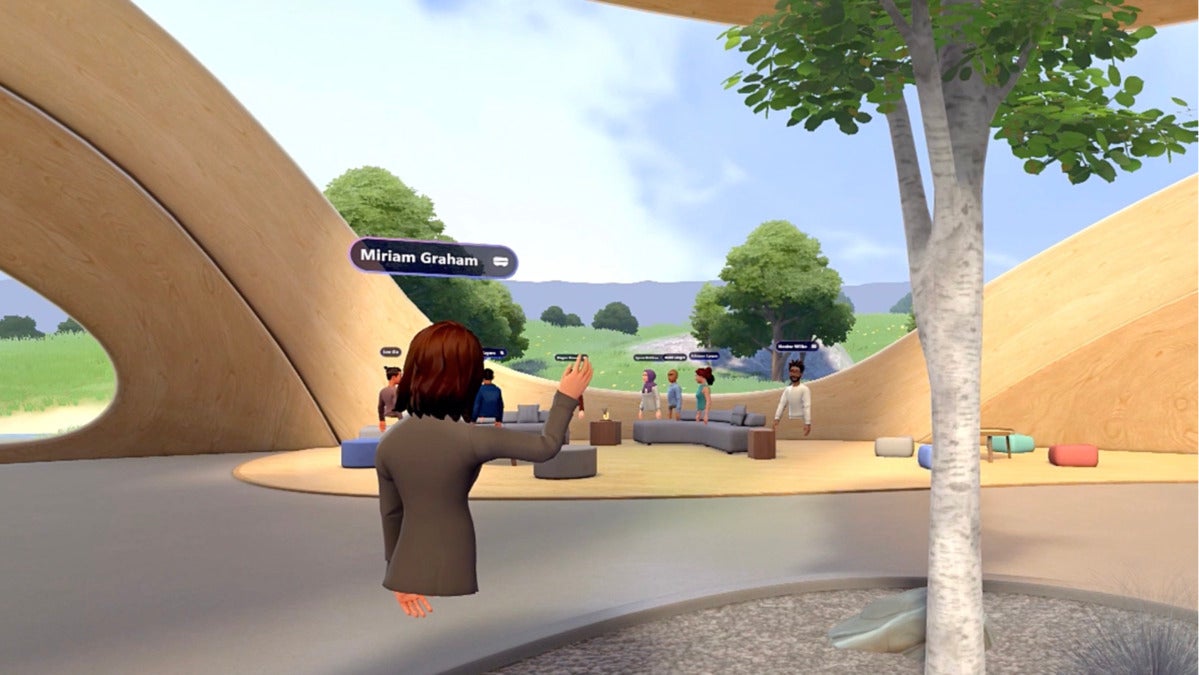Amid the numerous AI-related announcements at its Build developer conference this week, Microsoft also delivered updates on key aspects of its vision of a workplace “metaverse,” with the release of avatars for Teams and private previews of its Mesh mixed-reality tools.
Microsoft unveiled its Mesh concept in 2021, promising a range of tools and features, including a development platform to build mixed-reality apps, a virtual collaboration app, and avatars for Teams.
More recently, the company’s commitment to delivering mixed-reality products has been questioned after reports of layoffs affecting Microsoft’s “industrial metaverse” and HoloLens teams in February. (Microsoft later argued in a blog post that its commitment to the industrial metaverse space is “unwavering”, but in March, it also shuttered AltspaceVR, the social VR platform it acquired in 2017.)
At Build, however, Microsoft took several steps towards delivering on its metavervse vision around immersive meetings.
Avatars within Teams are now generally available to Microsoft 365 Business and Enterprise customers via the Teams desktop client for macOS and Windows.
“Avatars for Teams offers an alternative to the current binary option of video or no video in Teams meetings,” said Lori Craw, director of marketing for Modern Work at Microsoft in a blog post Tuesday. “Customizable avatars and reactions give you a much-needed camera break while showing colleagues that you are present — encouraging engagement, collaboration, and fun.”
“Despite their recent layoffs, [Tuesday’s] announcements about Microsoft Mesh and avatars for Teams show that Microsoft is still working to bring more engaging and immersive experiences to Microsoft 365 customers,” said Christopher Trueman, principal analyst at Gartner covering digital workplace applications.
Nevertheless, users may be underwhelmed by the new feature at launch, he said. “This isn’t an issue with the avatars themselves,” he said, which are of “good quality and offer plenty of customization options.”
It’s more an “an issue with how they are implemented and the impact this has on the experience of using them in Microsoft Teams,” he said.
Unlike avatars that track motion via a user’s webcam, such as those available in rival video platforms including Zoom, Teams avatar movements are generated from pre-built animations. This limits avatar expressions to what Microsoft’s designers have envisioned, said Trueman.
Another issue is that, while animations such as the wave, thumbs-up and heart animation are tied to existing emoji “reactions” in Teams, others are accessible via a separate avatar menu. As a result, some animations can’t be accessed when other Teams features — the participant list, lobby functionality, in-meeting chat, and screen-sharing — are in use, said Trueman.
“This makes for a disjointed experience that risks distracting users more than it engages them,” he said.
To Microsoft’s credit, he added, lip-synching is supported, and an avatar’s mouth will move whenever a user speaks, “but the overall experience is more limited and cumbersome than it could be. As such, it may be best to think of the initial launch of Avatars for Microsoft Teams as a minimally viable product.”
Trueman also noted the larger question of business acceptance of avatars at work. Most companies have yet to tackle challenges presented by avatars and immersive technologies, he said.
“Will employees’ avatars be required to match their real-life physical appearance? Are any animations/gestures considered inappropriate for certain work activities (for example, dancing animations)?” he said.
Some companies might simply disable avatars for Teams, he said.
Microsoft Mesh gets an update, too
Microsoft also rolled out an update for Mesh immersive experiences within Teams. The feature, now in a private preview, provides a 3D virtual space for colleagues to meet and can be accessed via a PC as well as with a VR headset. In these “immersive spaces,” Teams users can walk up to participants to talk to, with spatial audio enabling users to “experience sound as you would in an in-person setting,” Craw said.
 Microsoft
MicrosoftMicrosoft rolled out an update for Mesh immersive experiences within Teams.
Microsoft is also making the Mesh development platform available in a private preview so developers can build customized immersive spaces tailored to different workplace collaboration scenarios such as social gatherings, employee onboarding, or town halls.
Microsoft Mesh is the underlying platform set to power these and future experiences in Microsoft’s ecosystem.
“This platform-centric approach is differentiating for Microsoft, as many vendors in the emerging metaverse market have instead opted to build large, but flexible, applications [that] attempt to deliver a full set of metaverse capabilities in a single, centralized system,” Trueman said.
“By designing Mesh as a platform, Microsoft is positioned to deliver a common, baseline set of capabilities, which can then be customized and hooked into various applications and services,” he said. “Avatars for Microsoft Teams is the first such endeavor, but Microsoft has already hinted at integration into Microsoft Whiteboard in previous blog posts and announcements.”
A wider range of Microsoft apps and services could easily “take advantage of Microsoft Mesh’s capabilities in the future,” he said.

